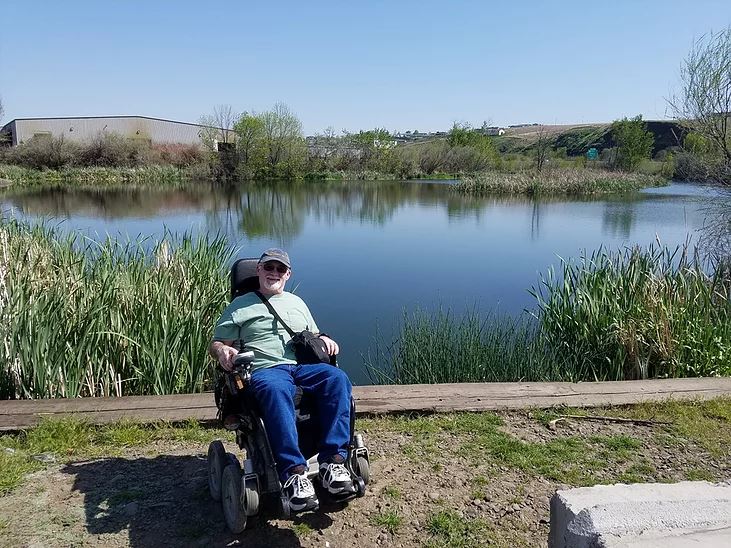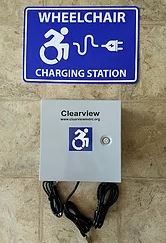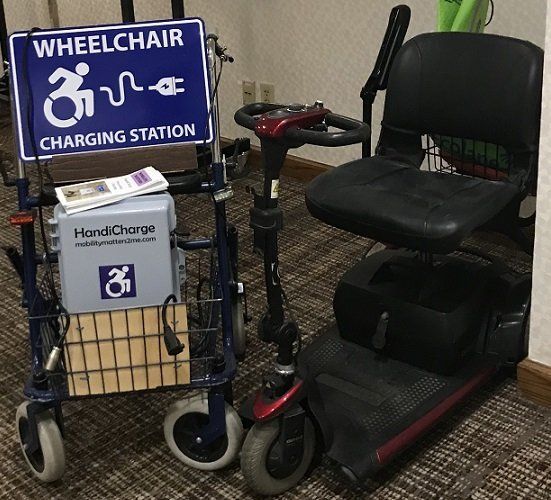Introduction
While forms of chairs on wheels have been around for centuries, and motorized wheelchairs have been around since the early 1900s, electric wheelchairs were first mass-produced in the 1950s. These mobility aids are also known as power chairs and electric powered wheelchairs (EPWs). Although data are limited, studies (2, 7) have estimated that between 5-23% of wheelchair users have electric wheelchairs.
The average wheelchair user spends about 10 hours in his or her wheelchair daily (8). Most power wheelchairs can travel over 10 miles before the battery becomes exhausted under ideal conditions (6).
Public transit systems may wish to consider offering riders the option of charging their wheelchairs while using transit services. Wheelchair charging stations have been set up in all sorts of buildings and public areas, including schools, courthouses, convention centers, chambers of commerce, farmers markets, libraries, parks, hospitals, malls, and even Disney World. Charging stations can be installed at transit facilities and inside transit vehicles. Scooters and other mobility devices with smaller batteries can also benefit from these charging stations, perhaps even more than power wheelchairs, because they have smaller batteries and can deplete and recharge faster than the larger batteries on the power wheelchairs.
While wheelchair battery chargers for individual use can easily be bought for under $100, wheelchair charging stations can cost anywhere from $450-$10,000.
How Wheelchair Battery Chargers Work
The batteries in power wheelchairs are different than batteries in cars, cell-phones or computers. A cell phone battery can simply be plugged into a charger for 15 minutes, and it is ready to go for another 2 hours. Wheelchair batteries are deep-cycle batteries, which achieve a full charge over a long, slow process. If a wheelchair battery has “died,” it may need to be charged for about 2 hours just to get it ready to take a full charge. It can take anywhere between 8-12 hours to fully charge power wheelchair batteries. However, some charging stations can fully recharge, or turbocharge, a chair in 45 minutes by connecting directly to the battery. The success of this method depends on factors including the charger current, the chair model, its wiring, and ability to safely accept a current. Please note that turbocharging wheelchair batteries can result in defective battery circuitry and/or shorten the battery’s life.
Dr. R. Lee Kirby, who heads the Wheelchair Research Team at Dalhousie University and wrote the textbook Wheelchair Assessment Skills and Training, recommends that it is ideal if both the wheelchair and the charger are turned off when being connected to each other and the power source. Then the power to the charger should be turned on.
Transit agencies that are interested in installing wheelchair chargers should look for battery charging systems that meet the International Standards Organization (ISO) standards for wheelchair chargers: ISO 7176-25:2013, Wheelchairs — Part 25: Batteries and Chargers for Powered Wheelchairs. The standards cover electrical safety, performance-related safety, charging capability, and electromagnetic compatibility for battery chargers, and ANSI/RESNA Wheelchair Standards requirements. Agencies also use chargers that comply with the regulations set forth in 10 CFR 430, Energy Conservation Program: Energy Conservation Standards for Battery Chargers, effective June 13, 2018.
Success Stories
New Technologies
While this is a fairly new technology in general, enhancements to wheelchair charging station apparatus are evolving at a rapid pace.
In 2019, Complete Coach Works (CCW) was the first bus company to offer wheelchair charging station retrofits so passengers could charge their wheelchairs at each securement location in the bus. Their charging station is compatible with all types of buses. Each wheelchair securement location includes a plug outlet, so riders can plug in their cords and charge while riding. These outlets have the same functionality as standard wall outlets and charge the batteries at the same rate.
The city of Shasta Lake, CA installed a fully renewably energized electric vehicle charger, the Envision Solar EV ARC standalone Solar Charging Station, in a parking lot and made it available free of charge to the public. The unit is equipped with a standard Level II electric vehicle charger and power outlets to enable electric wheelchair charging. This type of charger generates and stores all its own energy through solar power.
Many of the newer charging stations have universal hookups that will fit many types of power wheelchairs. Wireless wheelchair charging pads also are in the pipeline for development. Research is already underway for the next generation of charging stations, which may include hands-free charging stations, intelligent wheelchair charging technology, smart grid chargers that optimize charging cycles to occur primarily during the local electric company’s 'off-peak' hours when electricity costs are lower, and autonomous wheelchairs that can navigate to charging stations by themselves, and connect and charge automatically.
Wheelchair battery technology is likely to evolve as well. One example is a Zinger Chair, which is not a power wheelchair, but is a mobility device with a lithium-ion battery that can be charged on the chair or removed for charging at a charging station. The chair includes a battery indicator control panel indicating the battery life, and the battery can fully charge in under 4 hours for 5-8 miles of travel.
Advice and Best Practices
Mobility Matters 2 Me sells wheelchair chargers and provides the following practical advice:
- Charger boxes should be mounted on a wall near an electrical outlet. Do not install them higher than 4 feet in order for wheelchair users to be able to access them.
- Prime locations for the chargers are somewhere convenient for the user to spend at least ½ hour.
- Outdoor wheelchair charging units should be located undercover to protect the user and the charger from extreme weather conditions.
- Charging stations can be moved easily by attaching them to a cart or other mobile device.
Transit agencies should also keep in mind:
- If purchasing the charging stations with federal funding, the transit agency must comply with all necessary procurement, asset management, and reporting requirements.
- Wheelchair charging stations and associated signage may need to match agency branding in terms of colors and graphics. If purchasing from a vendor, the transit agency should ask about customization. If the purchase be a competitive procurement, involving a request for proposals or invitation for bids, colors and other customization requirements should be included in the specifications.
- Charging stations may be targets for vandalism or theft, so agencies should have plans in place should this occur. A transit agency could install charging stations in locations that are staffed (such as a transit center with a customer service office or security personnel) and secure the charging stations when not staffed.
- Obtain a warranty that details vendor terms of service.
- Ongoing and preventive maintenance is important to assure safe and efficient operation of these units. Charging stations should be inspected frequently by trained personnel, especially if they are located outdoors.
- Keep up to date with the industry as technologies may change, and update any outdated equipment as necessary.
- Travel training programs should develop training specific to use of the wheelchair charging stations.
- Add information about the charging stations where applicable to print and online transit agency documents, such as your Rider Guide. Educate your riders on appropriate utilization.
West Livaudais, program coordinator at Oregon Office on Disability and Health, advises transit agencies considering installing wheelchair charging stations to educate their riders. Riders should be informed that giving their wheelchair battery a short “boost” charge on the bus or at/near a transit station is not a substitute for regular, overnight charging. “If someone is using short charges,” explains Livaudais, “they need to understand that they should also charge overnight or they can shorten the life of the battery.” A good practice would be installing signage explaining this on/near the wheelchair chargers and/or on transit agency web pages about the chargers.
NACDD is creating a Power Wheelchair Charging Station (PWCS) Best Practices guidance document that was written by the project’s five State Expert Advisors, representing the five CDC funded State Disability and Health Programs participating in the project. Some of NACDD’s recommendations include soliciting input and inviting engagement from people who depend on battery-powered mobility devices, and identifying appropriate persons or entities to install power wheelchair charging stations within communities to ensure consistency of installation techniques. Their guidance document will be posted on the NACDD website soon. If you would like a copy of this guidance, please contact Karma E. Harris, Public Health Consultant, Healthy Communities Lead, at
kedwards@chronicdisease.org.
Acknowledgements
National RTAP would like to thank the following individuals who contributed to this article: Kallie Arevalo, Marketing Manager, Complete Coach Works; Mayor William J. Barlow, City of Oswego, NY; Sandra L. Brundage, Youth Bureau Director, City of Salamanca; Mary Carney, Population Health Coordinator, Community & Population Health Improvement, HealtheConnections; Brad Carson, Director of Sales, Complete Coach Works; Beth Hamby, Senior Associate, The KFH Group; Karma E. Harris, Public Health Consultant, Healthy Communities Lead, National Association of Chronic Disease Directors (NACDD); Lizabeth Lafferty, Superintendent, Adams CBDD; West Livaudais, MPH, Program Coordinator, Oregon Office on Disability & Health; and Darrin Umbarger, CEO, Clearview Disability Resource Center.
References
- CCW becomes First to Offer Wheelchair Charging Station Retrofits. Metro, May 9, 2019. https://completecoach.com/complete-coach-works-becomes-the-first-to-offer-retrofits-for-wheelchair-charging-stations/
- Hubbard, Sandra L., et al. Distribution and Cost of Wheelchairs and Scooters Provided by Veterans Health Administration. Journal of Rehabilitation Research & Development. 2007; 44(4): 581–592. https://pubmed.ncbi.nlm.nih.gov/18247255/
- International Organization for Standardization. ISO 7176-25:2013, Wheelchairs — Part 25: Batteries and Chargers for Powered Wheelchairs. 2012. Excerpt available at https://www.iso.org/obp/ui/#iso:std:iso:7176:-25:ed-1:v1:en. Accessed August 27, 2019.
- Kirby, R. Lee. Wheelchair Assessment Skills and Training. CRC Press, 2016.
- Mobility Matters 2 Me. Instructions for Use. Available at: https://www.mobilitymatters2me.com/instructions-for-use. Accessed August 27, 2019.
- Pearlman, Jonathan L., et al. Evaluation of the Safety and Durability of Low-Cost Nonprogrammable Electric Powered Wheelchairs. Archives of Physical Medicine and Rehabilitation. 2005; 86(12): 2361-2370. https://www.archives-pmr.org/article/S0003-9993(05)00927-5/fulltext
- Smith, Emma M., et al. Prevalence of Wheelchair and Scooter Use Among Community-Dwelling Canadians. Physical Therapy. 2016 Aug; 96(8): 1135–1142. https://www.ncbi.nlm.nih.gov/pmc/articles/PMC4992144/
- Sonenblum, Sharon E., et al. Characterization of Power Wheelchair Use in the Home and Community. Archives of Physical Medicine and Rehabilitation. 2008 Mar; 89(3):486–491. https://www.archives-pmr.org/article/S0003-9993(07)01769-8/fulltext
- U.S. Department of Energy. 10 CFR 430, Energy Conservation Program: Energy Conservation Standards for Battery Chargers. Final Rule. 2016 Aug 12. https://www.federalregister.gov/documents/2016/06/13/2016-12835/energy-conservation-program-energy-conservation-standards-for-battery-chargers





